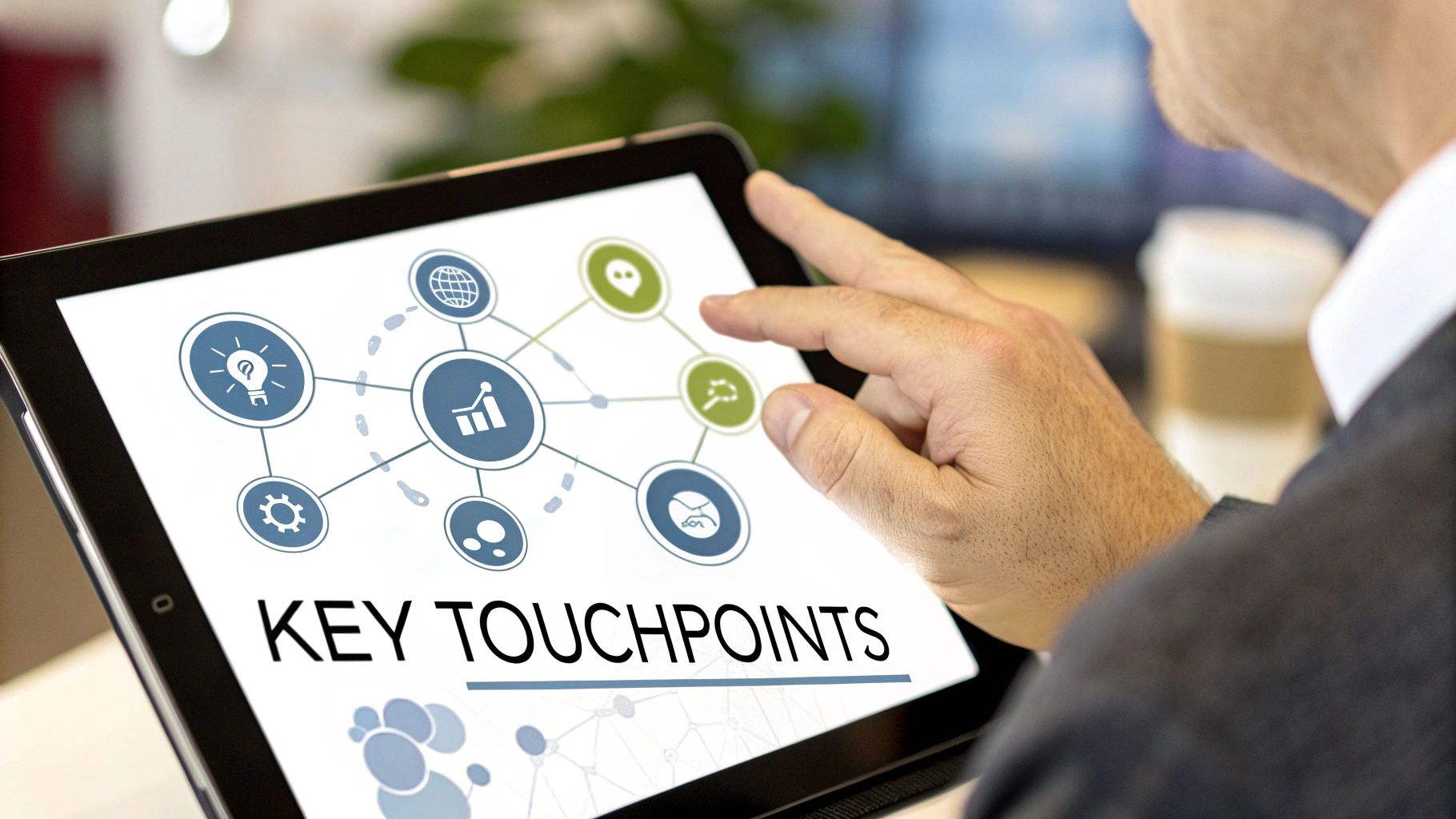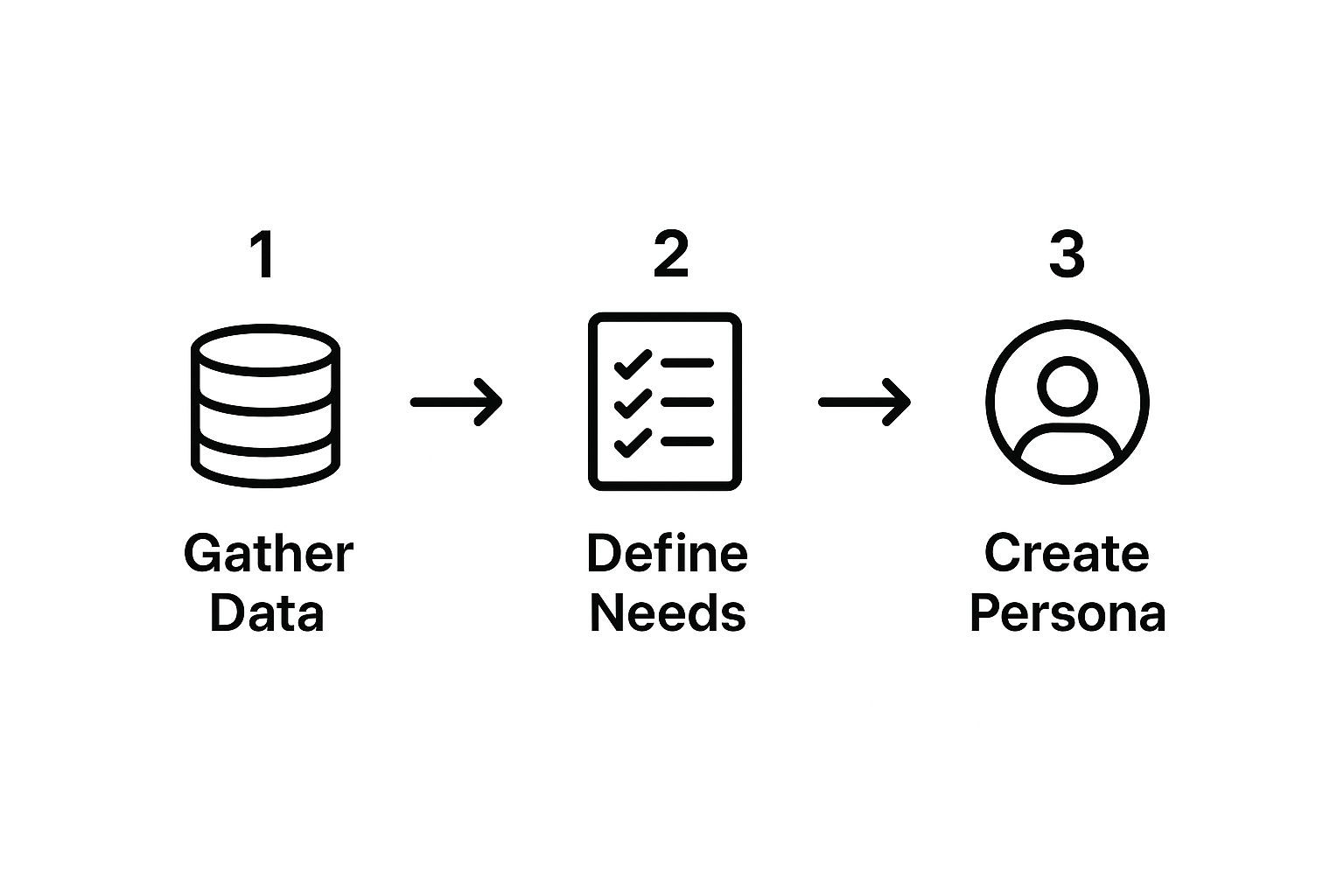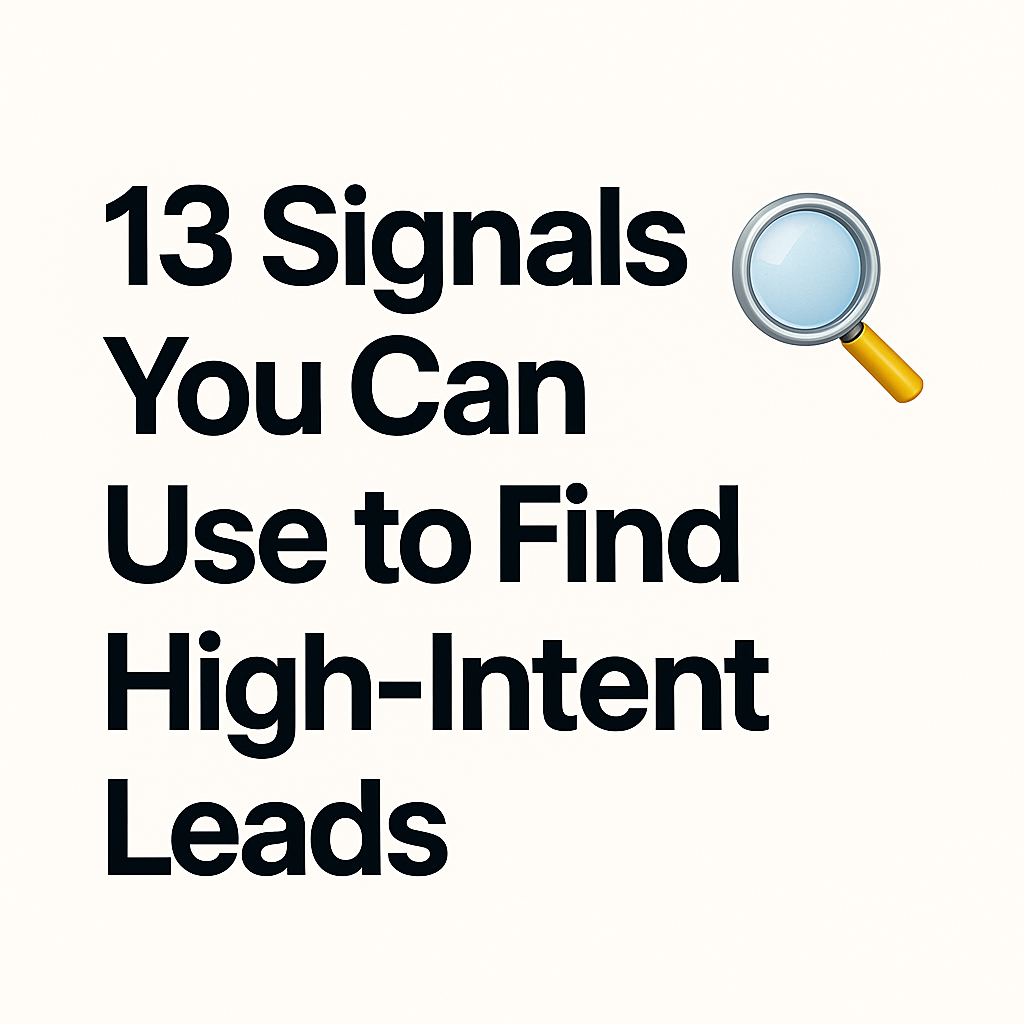B2B Customer Journey Mapping: A No-BS Guide to Winning More Deals

Let's be honest. B2B customer journey mapping is just a fancy term for visualizing every single interaction a business customer has with your company. It starts the first time they hear your name and carries all the way through to them becoming a loyal advocate. This isn't just about creating a flowchart; it's about developing a deep, empathetic look into their world.
Why Your B2B Strategy Feels Disconnected
Ever get that sinking feeling that your sales and marketing efforts are just... off? You know you have a fantastic product, and your team is sharp, but the high-quality leads aren't materializing the way you expect. If you're nodding your head, you're in good company. I've been there myself, staring at a CRM full of conversations that went nowhere, trying to figure out what I missed.
The piece you're likely overlooking is a genuine, boots-on-the-ground understanding of your customer's reality. That's precisely what B2B customer journey mapping delivers. Think of it less as a "nice-to-have" diagram for a PowerPoint slide and more as the bedrock of any successful modern B2B growth strategy.
The Mistake That Cost Me A Massive Deal
Early in my career, I was selling a complex software solution to a huge enterprise. I had a champion inside the company who absolutely loved our product, and I was convinced the deal was in the bag. A real slam dunk. So, I poured all my energy into him, sending over datasheets, case studies, everything he asked for.
What I completely failed to do was consider anyone else. I ignored the IT director who had to handle the integration, the person in finance who had to sign off on the budget, and the actual end-users who were nervous about learning a new system. I had mapped his journey, but no one else's.
The result? The deal completely imploded. The IT director raised security concerns I'd never bothered to address, and the finance team killed it because I hadn't built a clear ROI case that spoke to their department's needs. It was a painful, and very expensive, lesson. 😅
What to NEVER do: Never, ever assume your main contact is the only person who matters. In B2B, you are never selling to just one person. You're selling to a buying committee, a group of individuals with wildly different goals, fears, and questions. Ignoring this is a blueprint for disaster.
Shifting From A Pitch To A Partnership
When you do B2B customer journey mapping right, it forces you to make this exact shift. You move away from a one-size-fits-all sales pitch and into a more consultative, partnership-style approach. You stop talking at people and start truly understanding them.
This whole process is designed to uncover the things you're currently missing:
- Hidden Pain Points: What are the deep-seated frustrations your prospects are dealing with that they might not even mention on a sales call?
- Key Questions at Each Stage: What does the CTO need to know, and how is that different from what the project manager is asking?
- Emotional Drivers: What are their fears about making the wrong decision? What are their personal hopes for what your solution can help them achieve in their career?
Mapping out the journey shines a light on all these hidden opportunities. It's how you build a sales and marketing process that feels genuinely helpful and guided, not pushy or transactional. Ultimately, it’s the difference between a prospect ghosting you and one who sees you as an indispensable guide on their path to success.
Building Buyer Personas That Actually Work
Let's get practical. A journey map is useless if you don't know who is actually on the journey. But be honest: how many times have you seen buyer personas that are just a collection of vague demographics and a cheesy stock photo? They end up feeling like cardboard cutouts, not real people.
I'll never forget a huge mistake I made early on. We created this one-size-fits-all persona, "Marketing Mike", for a complex B2B sale. We assumed everyone in the marketing department thought and acted like him. This was a catastrophic failure because we completely missed the needs of "Finance Fran" who controlled the budget and "IT Ian" who had to approve the integration. Don't make my mistake.

Go Beyond Basic Demographics
To build personas that actually work, we need to dig deeper than just a job title and company size. We need to understand their inner world, their psychographics. What are their real challenges? What keeps them up at night? What are the key triggers that make them even start looking for a solution like yours?
A hard lesson learned: Creating one generic persona for a complex B2B sale is a recipe for disaster. You aren't selling to a faceless company; you're selling to a committee of individuals, each with their own goals and fears. You have to map out the entire buying committee.
The first step in any B2B buyer journey map is deep research into your target audience. This means gathering intel from your sales team, surveying your best customers, analyzing user behavior data, and even listening in on social media. This deep dive is what creates a clear, actionable buyer persona, which is absolutely essential for understanding their true pain points and motivations.
Your Goldmine of Persona Data
So, where do you find all this juicy information? It’s closer than you think. You don't need a massive budget; you just need to know where to look.
Here's where I always start:
- Talk to Your Sales Team: They are on the front lines every single day. Ask them: "What are the most common objections you hear? What 'aha!' moments do customers have on calls? Who are the real champions, and who are the gatekeepers?"
- Dive Into Your CRM: Look at the data for your best customers. What were the common pathways they took? Which content did they engage with? What are their job titles? This is a treasure trove of behavioral data.
- Conduct Targeted Surveys: Don't just ask "Are you satisfied?" Ask probing questions like, "Before you found us, what was the biggest frustration in your workflow?" or "What goal were you trying to achieve when you started looking for a solution?"
- Leverage Social Listening: What are your target customers talking about on LinkedIn? What questions are they asking in industry groups? This is unfiltered, raw insight. In fact, you can master this with some solid guidance on how to turn social media into a sales machine.
By combining these data sources, you move from flimsy, imagined personas to robust, data-driven profiles that feel like real human beings. This is the bedrock of your entire B2B customer journey mapping effort. Without it, you're just guessing. With it, you're building a strategy based on truth.
Your Practical Guide To Mapping The B2B Journey
Ready to roll up your sleeves and build your map? Let’s get to it. This isn't some abstract theory; it’s a hands-on walkthrough for creating something genuinely useful for your business. We're aiming for a functional tool that lays bare every gap and point of friction in your current process.
We’ll start by defining the core stages of a typical B2B sale, moving from initial Awareness right through to long-term Advocacy. But here's where the real work begins: for each stage, we need to pinpoint the critical touchpoints, every single interaction a prospect has with your brand.
Think about it. A LinkedIn post they scroll past, a webinar they attend, a demo call with your sales team, even a support ticket they submit after becoming a customer. They all shape the experience. Have you ever really sat down and listed them all out?
Laying The Foundation: Stages and Touchpoints
I once tried to map a journey without clearly defining the stages first. Big mistake. 🤦♂️ We had touchpoints all over the place with no structure. It looked like a plate of spaghetti and was completely unusable. Don't make that same error. Structure is your friend here.
So, let's start by looking at what those stages actually are.
Most B2B journeys follow a familiar path. Here’s a simple table breaking down the stages, what your customer is trying to achieve in each, and some common places they'll interact with you.
This framework gives you a solid skeleton to build upon. For each of these stages, you need to list every single touchpoint. Go on, grab a whiteboard or open a blank document. Get your sales, marketing, and customer success teams in a room (virtual or physical) and just brainstorm. You’ll be shocked at how many interactions there really are.
What to NEVER do: Don't map this alone from your desk. Your view is biased. You must involve people from different departments. A sales rep’s view of the 'Decision' stage is wildly different from a marketer's. You need both perspectives for an accurate map.
The initial steps are all about gathering data, clarifying your customer's needs, and creating a solid persona that keeps your mapping process grounded in reality.

This flow highlights that effective mapping isn't guesswork; it's a structured process that starts with real data and a deep understanding of your audience.
Documenting Goals, Questions, And Emotions
Now for the part that separates a good map from a truly great one. For every single touchpoint you've listed, you need to answer a few key questions from the customer's point of view:
- What is their goal? What are they trying to accomplish in this specific interaction?
- What are their questions? What information do they need right now?
- How are they feeling? Are they optimistic, confused, frustrated, or excited?
Being brutally honest about their emotional state is crucial. I remember mapping a client's onboarding process. On paper, it looked perfectly logical. But when we actually talked to new customers, we found the feeling during the data import stage was pure anxiety. They were terrified of messing it up and breaking something.
That single emotional insight led to creating a new "white glove" import service, which not only solved the problem but became a huge value-add they could promote.
Tools Of The Trade
You don't need fancy, expensive software to get started. Honestly, my first few maps were just a massive whiteboard covered in sticky notes. It’s incredibly effective for collaboration and getting ideas out quickly.
- Low-Tech: The classics still work. Whiteboard, sticky notes, and a few different colored markers. Simple and powerful.
- Digital Whiteboards: For remote or hybrid teams, platforms like Miro or Lucidchart are fantastic. They even have pre-built templates for B2B customer journey mapping to give you a head start.
- Spreadsheets: Never underestimate a well-organized spreadsheet. A simple Google Sheet or Excel file can work wonders for listing out your stages, touchpoints, goals, and pain points before you visualize them.
The tool doesn't matter nearly as much as the process. Just pick something your team will actually use. The goal here is a tangible map you can act on immediately—not a pretty picture that gets forgotten in a folder.
Turning Your Journey Map Into Action And Revenue
You did it. You’ve got a beautiful, insightful B2B customer journey map laid out in front of you. High-five! 🙌 But let’s be honest for a second: a map collecting dust on a wall (or buried in a shared drive) is completely worthless. A map that actively guides your strategy, on the other hand, is priceless.
This is where the real work, and the real fun begins. It’s time for activation. Now that you’ve put a spotlight on all the pain points and golden opportunities, how do you turn those insights into actual revenue?
From Insights To Actionable Fixes
I remember staring at a journey map for a SaaS client a few years ago and finding a massive drop-off during the 'Consideration' stage. Prospects would attend a great demo, seem genuinely excited, and then… radio silence. They just ghosted. Sound familiar?
Our first instinct was to have sales follow up more aggressively. That would have been the wrong move. The map showed us the real problem: after the demo, prospects were sent to a generic competitor comparison page where they got overwhelmed and confused. The emotion we identified was decision paralysis.
Instead of more follow-up emails, we created a tailored "Post-Demo Package" for each key persona. For the CTO, it included a deep-dive security document. For the Marketing Director, it had three hyper-relevant case studies from their industry. This small, strategic change was a game-changer.
What to NEVER do: Don't just guess at solutions. Your map gives you the "why" behind the problem. Use that insight to craft a precise fix instead of throwing random tactics at the wall to see what sticks.
Brainstorming Solutions For Common Problems
Let's walk through some common issues you might uncover and what you can actually do about them.
- Problem: Prospects are ghosting you during the Consideration stage.
- Actionable Fix: Develop targeted comparison guides that honestly stack you up against competitors. Create in-depth case studies that prove your ROI, or host a Q&A webinar with a current customer to build that crucial social proof.
- Problem: The Onboarding stage is a source of frustration and anxiety.
- Actionable Fix: Build out a more robust support system. This could mean a step-by-step video tutorial series, offering a "white glove" setup service, or establishing a dedicated onboarding specialist for new accounts.
- Problem: You're losing customers after the first year (Retention stage).
- Actionable Fix: The journey doesn't stop at the sale! Implement quarterly business reviews (QBRs) with a customer success manager to demonstrate ongoing value. Create an exclusive customer-only newsletter with advanced tips and new feature announcements.
This is exactly how you connect the dots between customer delight and your bottom line. It’s about making small, strategic changes that produce huge results.

This is where data-driven relational marketing truly shines. For example, Dell Technologies' "I.T. Squad" campaign focused on creating personalized interactions by using data analytics to understand customer needs deeply. This resulted in a 25% increase in customer satisfaction scores, proving that a focus on experience directly impacts business metrics.
By identifying exactly where your prospects are struggling, you can deliver the perfect content or support at the perfect time. This is also where you can get smarter with your lead generation. If you know a certain action on your website is a major buying signal, you can act on it immediately. You can pinpoint these high-intent signals in our detailed guide.
The goal is to prove the ROI of your journey mapping work to the entire company. When the finance team sees retention go up and the sales team sees conversion rates climb, your map transforms from a simple diagram into the company's strategic playbook.
Common B2B Journey Mapping Mistakes To Avoid
Alright, let's have a brutally honest chat. I’ve seen some real journey mapping disasters over the years, and I'll admit, I've made a few of these mistakes myself. It’s easy to do. On the surface, mapping seems straightforward, but a few common traps can quickly turn a powerful strategic tool into a pretty but useless diagram gathering dust on a server.
Think of this as your guide to sidestepping the landmines. Let’s dive into the biggest pitfalls I see teams fall into time and time again.
The "Inside-Out" Perspective
This is, without a doubt, mistake number one. It happens when a company maps the journey based on how they think it works from inside their own walls. They meticulously document their sales process, their marketing funnel stages, and their support handoffs. The problem? Your customer doesn’t know or care about your internal processes.
I once worked with a team that built an immaculate map based entirely on their Salesforce stages. It was neat and tidy, but it was pure fiction. It completely missed the messy, non-linear steps their prospects actually took, like getting informal advice from peers on LinkedIn or watching a dozen third-party review videos before ever speaking to a sales rep.
What to absolutely do: Start with real customer interviews and behavioral data. Your map must reflect the customer's reality, not your company's org chart.
Ignoring The Emotional Rollercoaster
A B2B purchase isn't just a logical, box-ticking exercise. It's an emotional rollercoaster. 🎢 There's excitement about a potential solution, anxiety about making the wrong choice, frustration with internal bureaucracy, and immense pressure to deliver ROI. If your map is just a series of actions without capturing these feelings, you’re missing half the story.
Remember, you're selling to human beings who have careers and reputations on the line. Acknowledging that the Head of IT feels anxious about data migration or that a Project Manager feels overwhelmed during onboarding is critical. These emotional insights are where you'll find your biggest breakthroughs for improving the experience.
Creating A "Set It And Forget It" Map
A journey map is not a one-and-done project. It’s a living document that needs to breathe. The market changes, your product evolves, and customer expectations are constantly shifting. A map you created just a year ago might already be dangerously out of date.
Here’s how to keep your map from becoming a fossil:
- Schedule a quarterly review: Put a recurring meeting on the calendar with key people from sales, marketing, and customer success. The only agenda item? "What has changed in our customer's world?"
- Assign an owner: Make one person responsible for the map's upkeep. When it's everyone's job, it's no one's job.
- Integrate real-time feedback: Use customer survey data (like NPS and CSAT scores) and support tickets to constantly feed fresh insights back into your map.
Forgetting The Post-Purchase Journey
So many teams pour all their energy into mapping the path to the sale and then just... stop. Big mistake. The journey doesn't end when the contract is signed. For retention and advocacy, it's just beginning.
Onboarding, adoption, support, and renewal are all critical stages where you can either create a loyal advocate or a disgruntled ex-customer who churns. Mapping this post-purchase experience reveals crucial opportunities to improve retention, which is far cheaper than acquiring a new customer. Don't let your map fall off a cliff right after the "Decision" stage.
How to Future-Proof Your Strategy with a Dynamic Map

You’ve built your map, pinpointed the friction, and started making improvements. So, what now? The biggest mistake you can make is letting all that hard work turn into a static document that just gathers dust. Your map isn't a museum piece; it's a living, breathing dashboard for your customer experience. This is where you future-proof everything.
Let's be real: the entire B2B sales world is shifting online at an incredible speed. Projections show that by 2025, a massive 80% of B2B sales interactions will happen in digital channels. This digital-first reality means a dynamic, buyer-focused approach isn't just a nice-to-have, it's essential for survival. You can dig deeper into this trend with research from ReachStream. Your journey map is the key to navigating this shift.
Making Your Map A Dynamic Tool
The goal is to transform your map from a simple snapshot into a real-time feed of what's actually happening with your customers. I learned this the hard way. Early in my career, I created a beautiful map and then only scheduled an annual review. Big mistake. Within six months, a new competitor launched, and our customers' questions and anxieties completely changed. My once-perfect map was suddenly obsolete.
Don't fall into the same trap. Here's how to keep your map relevant and powerful:
- Set Up Automated Feedback Loops: Integrate simple survey tools (like NPS or CSAT) at critical post-purchase touchpoints. Make sure that data gets routed directly to the person who owns the journey map.
- Watch for Real-Time Signals: Use tools that show you what customers are really doing. Think website heatmaps or intent data platforms like GojiberryAI. These reveal where customers are actually going, not just where your map assumes they are.
- Hold Quarterly Reviews: Book a recurring meeting every quarter with sales, marketing, and customer success. The agenda should have one core question: "What's changed in our customers' world?" This is non-negotiable.
Your Path to Unlocking Growth
Okay, you’ve made it this far, which means you're serious about this. You've seen the common pitfalls, you know the step-by-step process, and you understand that a map is more than just a document, it's a mindset shift.
Your B2B customer journey mapping isn't a one-and-done project; it’s a fundamental change in how your company operates. It’s the engine of a truly customer-first culture that stops guessing and starts guiding. This map is your secret weapon to not only close more deals but to build a base of loyal customers who see you as an essential partner.
Now, the ball is in your court. Be the champion for this mindset within your organization. Use your map as the evidence you need to challenge old assumptions and drive real, meaningful change. You have the blueprint. It's your key to thriving, not just surviving. Go make it happen. 💪
Frequently Asked Questions
How is a B2B journey map different from B2C?
Think of it like this: a B2C map is like charting a single hiker's path up a mountain. A B2B map is like charting an entire expedition team, where each member (IT, Finance, Legal, the End-User) has a different role, different gear, and a different opinion on which path to take. B2B journeys are longer, involve more decision-makers, and carry much higher financial and professional stakes. The complexity is just on another level.
How often should I update my customer journey map?
I treat my journey map like a living, breathing plant, not a plastic one. 🌿 It needs regular care. My advice? Do a major review and refresh at least once a year, or anytime your business makes a significant pivot (like a new product launch). But more importantly, hold a quarterly check-in with your sales, marketing, and success teams. This keeps your map from becoming a historical artifact and ensures it reflects the current reality of your customers.
What are the best free tools to start mapping?
You don't need to spend a dime to start. My all-time favorite low-tech tool is a physical whiteboard covered in sticky notes. It’s collaborative and forces you to think clearly. For digital and remote teams, platforms like Miro, Mural, and Lucidchart offer amazing free versions with pre-built B2B customer journey mapping templates. Heck, you can even start with a Google Sheet. The tool isn't the magic; the collaborative thinking is.
Who should be involved in creating the map?
Please, whatever you do, don't try to create this alone in a dark room. Your map will be a work of fiction. Journey mapping is a team sport. You absolutely need a cross-functional squad to get this right. Your non-negotiable invite list should include:
- Sales: They know the objections and deal-breakers.
- Marketing: They understand the top-of-funnel discovery process.
- Customer Success/Support: They have the priceless insights on what happens after the sale.
- Product: They can connect customer pain directly to feature improvements.
Getting everyone in the same (virtual) room not only creates a better map but also builds the buy-in you'll need to actually implement the changes you uncover. If you have more questions, you can also explore these additional FAQs for further insights.
More High-Intent Leads = Your New Growth Engine.
Start Now and Get New High Intent Leads DeliveredStraight to Slack or Your Inbox.






.png)


